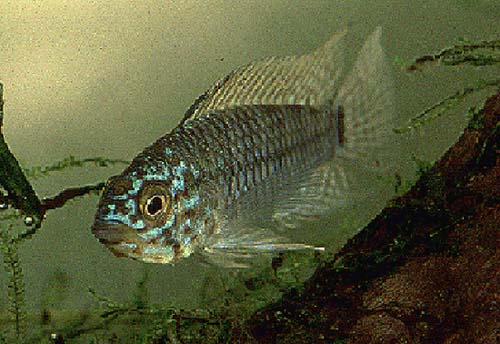
Apistogramma cf. resticulosa
Distribution: Ilha de Marajo at the mouth of the Amazon (?)Size: 2 inches
Comments: After viewing the above image, Dr. Ingo Koslowski said "This A. cf. resticulosa seems to be the fish called Wangenflecken-Ap. in the german hobby (often misidentified as A.resticulosa). It comes from the Ilha de Marajo at the mouth of the Amazon."
It is a very hardy aquarium resident and also quite capable of defending itself - the fish you see here occasionally intimidated a full grown Uaru!
Mike Wise of Denver, Colorado wrote the following when the identity of this fish was brought up in the Dwarf Cichlid Mailing List. "I don't think this is A. sp. Wangenflecken. The caudal spot is too long and narrow for Wangenflecken. The bands in the tail are too prominent and I think I see a darker Bar 7 showing below the lateral band (typical of the caetei-complex).
As Ken says it looks like the fish pictured on p. 54 as A. caetei Blaukopf/Blue-head in Mayland & Bork's book. In Römer's Atlas it is listed as A. sp. Steel Blue and in Matuzaka, et. al. as A. sp. New Blue. Matuzaka considers it a domestic cross between a resticulosa- & caetei-complex species. Römer states that Steel Blue was bred in Germany from Asian males and wild females. My question is where and how did the German breeder find wild females when the species is only known from domestic bred fish. I believe that they used whatever would work and didn't really care if it was a hybrid. Obviously it is fertile and doesn't show any hybrid deformities seen in some apisto crosses. This is OK if you realize that they are breeding a domestic hybrid to produce a colorful fish - like Red Swordtails (Xiphophorus helleri x X. maculatus x X. variatus x ???). It's not a fish I personally want to keep. There are just too many colorful true species out there to work with.
By the way, the fish listed as Blue-head & pictured in the Aqualog Book (SAII) on p. 28 (bottom 2 photos) is not the same fish. They are a pair of cacatuoides-like A. luelingi.
Now if you want some Wangenflecken (the species is shown as A. resticulosa on p. 116 & 117 in Linke & Staeck, 1994). Dominic Isla has a few that came in as contaminants. Check out the latest ApistoEmporium & ACA Trading Post. (I identified them)
To answer Stephs question, the real A. resticulosa has been exported by Trop Rio (Marco Lacerda) and is available in the hobby. I know Ade Lau has photos of them on his web page. Whether or not the fish Steph saw in Perth (Australia) are the real resticulosa or not is difficult to say. Live A. resticulosa is not easy to recognize. There are several populations in the Rio Madeira/Purus drainage that may be separate species or just color forms. A. resticulosa is hard to separate from A. taeniata, too. There are probably a half dozen or more species?/color forms of this fish, too. For now I just try to keep the populations separate and call all the species above Manaus (and not from the type locality) "A. cf. resticulosa (location)". Those below Óbidos (and not from the type locality) I call "A. cf. taeniata (location)". Anything between Manaus and Óbidos I just hope doesn't exist (LOL).
Confused? Welcome to the club!!
| Back to ==> Home / Neotropical Cichlids / Apistogramma cf. resticulosa |
| Home | Pikes | Neotropicals | Collecting | Photography | Personal | Links | Site map |

|
http://geocities.datacellar.net/NapaValley/5491
Latest update: 20 February 2000 Comments on this page: E-Mail author |